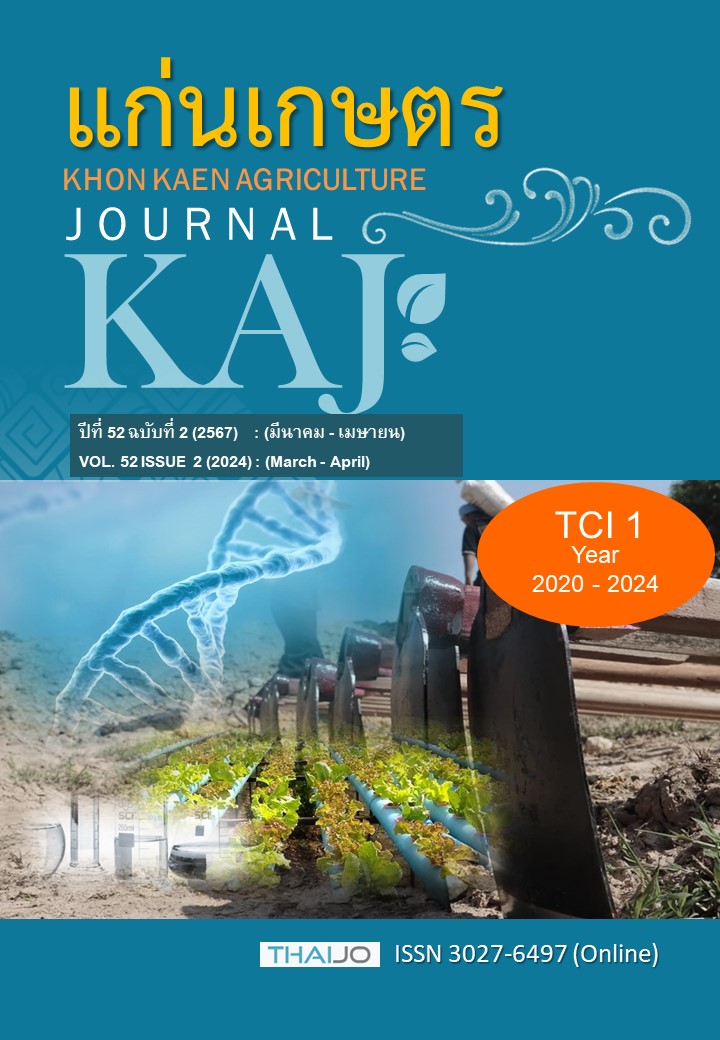ผลของการเสริมสมุนไพรต่อประสิทธิภาพการผลิตและคุณภาพไข่
Main Article Content
บทคัดย่อ
การใช้สมุนไพรเพื่อทดแทนสารปฏิชีวนะในอุตสาหกรรมการผลิตไก่ไข่ สามารถช่วยกระตุ้นการย่อยอาหาร การดูดซึมอาหาร การป้องกัน และรักษาโรค รวมถึงส่งเสริมให้องค์ประกอบภายในฟองไข่ และคุณภาพไข่ไก่ดีขึ้น งานวิจัยนี้มีวัตถุประสงค์เพื่อศึกษาผลของการเสริมสมุนไพรต่อประสิทธิภาพผลิตของไก่ไข่ และองค์ประกอบภายในฟองไข่ ทำการทดลองในไก่ไข่เพศเมีย สายพันธุ์ Hy-line brown อายุ 60 สัปดาห์ โดยวางแผนการทดลองแบบ randomized complete block design (RCBD) โดยแบ่งกลุ่มทดลองออกเป็น 2 กลุ่ม ดังนี้ กลุ่มที่ 1 กลุ่มควบคุมได้รับอาหารพื้นฐาน (C) กลุ่มที่ 2 กลุ่มทดลองได้รับอาหารพื้นฐานเสริมสมุนไพร (T) แบ่งเป็นกลุ่มละ 4 ซ้ำ ซ้ำละ 5 ตัว รวม 20 ตัว โดยในแต่ละซ้ำจะแบ่งตามประสิทธิภาพการให้ไข่ก่อนการทดลอง 14 วัน นำมาคำนวณหาประสิทธิภาพการผลิตการให้ไข่รายตัวแบ่งตามระดับได้เป็น 4 ควอไทด์ดังนี้ คือ ระดับไม่ดี (Q1) ต่ำกว่า 25% ระดับพอใช้ (Q2) 25-50% ระดับดี (Q3) 50-75% และระดับดีมาก (Q4) 75-100% ให้อาหารไก่ไข่ 120 กรัม/ตัว/วัน ให้น้ำอย่างเต็มที่ (ad libitum) ผลการทดลองพบว่ากลุ่มไก่ไข่ Q1 ที่ได้รับอาหารพื้นฐานเสริมสมุนไพร มีน้ำหนักไข่แดงเพิ่มขึ้น (P<0.05) กลุ่มไก่ไข่ Q2 ที่ได้รับอาหารพื้นฐานเสริมสมุนไพรมา 21 วันมีน้ำหนักไข่ ความหนาของเปลือกไข่ และน้ำหนักไข่ขาวเพิ่มสูงขึ้น (P<0.05) กลุ่มไก่ไข่ Q3 มีปริมาณการกินได้ และความแข็งของเปลือกไข่เพิ่มสูงขึ้น (P<0.05) ดังนั้นสมุนไพรเป็นอีกทางเลือกหนึ่งที่ช่วยฟื้นฟู การทำงานระบบต่าง ๆ ของร่างกายไก่ไข่ให้ดีขึ้น ซึ่งจะทำให้ไก่ไข่มีประสิทธิภาพการผลิต และทำให้องค์ประกอบภายในฟองไข่ให้มีคุณภาพดีมากขึ้น
Article Details

อนุญาตภายใต้เงื่อนไข Creative Commons Attribution-NonCommercial-NoDerivatives 4.0 International License.
เอกสารอ้างอิง
คัธรียา มะลิวัลย์ และกานต์ สุขสุแพทย์. 2558. ผลการเสริมฟ้าทะลายโจรในอาหารไก่ไข่ต่อสมรรถภาพการผลิตไข่และคุณภาพฟองไข่. น. 886-891. ในการประชุมทางวิชาการของมหาวิทยาลัยเกษตรศาสตร์ ครั้งที่ 53: สาขาพืช สาขาสัตว์ สาขาสัตวแพทยศาสตร์ สาขาประมง สาขาส่งเสริมการเกษตรและคหกรรมศาสตร์. 3-6 กุมภาพันธ์ 2558. มหาวิทยาลัยเกษตรศาสตร์, กรุงเทพฯ.
ณัฐธยาน์ หาได้, นฤมล สมคุณา และกันตพัฒน์ รัตนสินธุพงศ์. 2020. ผลการเสริมฟ้าทะลายโจรในอาหารต่อสมรรถภาพการผลิตของไก่พื้นเมืองพันธุ์เหลืองหางขาว. วารสารวิทยาศาสตร์และเทคโนโลยี มหาวิทยาลัยราชภัฏบุรีรัมย์. 4(2): 53–63.
นัฐวุธ มากศรี, นันทนา ช่วยชูวงศ์, ราชศักดิ์ ช่วยชูวงศ์ และเกียรติศักดิ์ สร้อยสุวรรณ. 2560. ผลการเสริมสมุนไพรฟ้าทะลายโจรและขมิ้นชันในอาหารต่อองค์ประกอบซากและคุณภาพเนื้อของไก่ไข่ปลดระวาง. แก่นเกษตร. 45(ฉบับพิเศษ 1): 20-25.
ทัศนีย์ อภิชาติสรางกูร. 2540. สุขศาสตร์สัตว์. สารพัดพิมพ์. เชียงใหม่.
อรทัย จินตสถาพร. 2556. สมุนไพรไทยเพิ่มประสิทธิภาพการผลิตสัตว์ปีก: สมรรถภาพการผลิตไข่ คุณภาพไข่และสุขภาพของไข่. วารสารปศุสัตว์เกษตรศาสตร์. 40(158): 56-66.
ไพทูล แก้วหอม และนวพร ช่วยณรงค์. 2558. ระดับที่เหมาะสมของกลีบกระเจี๊ยบแดง (Hibiscus sabdariffa Linn.) แห้งในอาหารไก่ไข่. สัตวแพทย์มหานครสาร. 10(2): 127-136.
Abu, M.N., S. Samat, N. Kamarapani, F.N. Hussein, W.I.W. Ismail, and H.F. Hassan. 2015. Tinospora crispa ameliorates
insulin resistance induced by high fat diet in Wistar rats. Evidence-Based Complementary and Alternative Medicine: eCAM, 2015, 985042. https://doi.org/10.1155/2015/985042.
Al-Nasrawi, M. 2013. Evaluation of Roselle (Hibiscus sabdariffa) flower as feed additives on the performance
and health of broiler chicks. The Iraqi Journal of Medicine Sciences. 37: 69-74.
An, B. K., H. Nishiyama, K. Tanaka, S. Ohtani, T. Iwata, K. Tsutsumi, and M. Kasai. 1997. Dietary safflower phospholipid reduces liver lipids in laying hens. Poultry Science. 76(5): 689-695.
Barbour, G. W., N. N. Usayran, S. K. Yau, S. K. Murr, H. A. Shaib, N. N. Abi Nader, G. M. Salameh, and M. T. Farran. 2016. The effect of safflower meal substitution in a lysine fortified corn-soybean meal diet on performance, egg quality, and yolk fat profile of laying hens. Journal of Applied Poultry Research. 25(2): 256-265.
Da-Costa-Rocha, I., B. Bonnlaender, H. Sievers, I. Pischel, and M. Heinrich. 2014. Hibiscus sabdariffa L. – A phytochemical and pharmacological review. Food Chemistry. 165: 424-443.
Chopra, I., and M. Roberts. 2001. Tetracycline antibiotics: Mode of action, applications, molecular biology and epidemiology of bacterial resistance. Microbiology and Molecular Biology Review. 65: 260-323.
Flores, W., A. L. Ruano, and D. P. Funchal. 2009. Social participation within a context of political violence: implications for the promotion and exercise of the right to health in Guatemala. Health Hum Rights. 11(1): 37-48.
Lal, G. S., and A. K. Panda. 2019. Impact of Neem Leaf Meal as a Feed Supplement in Poultry. Agriculture WORLD, 76-81.
Meshram, M., U. Shukla, R. Patile, and M. Bharadwaj. 2022. Effect of neem leaf powder on body weight of broilers. The Pharma Innovation Journal. SP-11(5): 1628-1630.
Mohammed, K., A. Ahmed, O. Bushara, A. Habib, and A. Abubakr. 2022. Utilization of Roselle seeds (Hibiscus sabdariffa) as a protein source for broilers. Asian Journal of Animal and Veterinary Advances. 17: 68-72.
Nopparatmaitree, M., A. Panthong, S. Paengkoum, and P. Saenphoom, 2014. Evaluation of asparagus trimmed waste in laying hens diet on nutrient digestibility and productive performance. Silpakorn University Science and Technology Journal. 8(1): 72-84.
Obikaonu, H., and A. Udedible. 2015. Evaluation of Neem (Azadirachta indica) leaf meal in the diets of Black Leghorn Laying Hens for protein sustainability and national development. Journal of Agricultural Technology. 11: 1089-1095.
Poonpipat, R., S. Isariyodom, S. Thummabood, and P. Sukprasert. 1999. Effect of herbal plant andrographis paniculata wall. ex Nees. supplementation in laying hen rations. Proceedings of the 37th Kasetsart University Annual Conference: Animal, Veterinary Science. Proceedings of the 37th Kasetsart University Annual Conference: Animal, (p. 102-107). Ministry of University Affairs, Bangkok (Thailand).
Ragab, H. I., K. A. Abdel Ati, C. Kijora, and S. Ibrahim. 2012. Effect of difference level of the processed Lablab purpureus seed on laying performance, egg quality and serum parameters. International Journal of Poultry Science. 11(2): 131-137.
Sabet Sarvestani, S., S. M. Hosseini, and S. H. Farhangfar. 2020. Effect of aqueous-alcoholic extract of Hibiscus sabdariffa calyx and leaf calyx and leaf on performance, egg quality, immune system and antioxidant balance of laying hens. Iranian Journal of Applied Animal Science. 10(2): 317-325.
Saeed, M., M. Naveed, J. Leskovec, I. Kakar, K. Ullah, F. Ahmad, M. Sharif, A. Javaid, M. Rauf, M. E. Abd El-Hack, M. A., Abdel-Latif, and S. Chao. 2020. Using Guduchi (Tinospora cordifolia) as an eco-friendly feed supplement in human and poultry nutrition. Poultry Science. 99(2): 801-811.
Sarvestani, S., S.M. Hosseini, and S.H. Farhangfar. 2020. Effect of aqueous-alcoholic extract of Hibiscus sabdariffa calyx and leaf calyx and leaf on performance, egg quality, immune system and antioxidant balance of laying hens. Iranian Journal of Applied Animal Science. 10: 317-325.
Sokołowicz, Z., J. Krawczyk, and M. Dykiel. 2018. The effect of the type of alternative housing system, genotype and age of laying hens on egg quality. Annals of Animal Science. 18: 541-555.
Tapingkae, W. 2014. Alternatives to the use of antibiotics as growth promoters for livestock animals. Journal of Agriculture. 30(2): 201-212.
Yau, S. K. 2004. Safflower agronomic characters, yield and economic revenue in comparison with other rain-fed crops in a high-elevation, semi-arid Mediterranean environment. Experimental Agriculture. 40(4): 453-462.
Zhao, L., X. Zhang, F. Cho, D. Sun, and T. Wang. 2003. Effects of dietary supplementation with fermented gingo-leaves on performance egg quality lipid metabolism and egg-yolk fatty acid composition in laying hens. Livestock Science. 155: 77-85.


